Welcome to Science in the month of February! Mr. John worked with us on some very exciting new science experiments.
At the beginning of each science experiment, Mr. John has us come up with our own hypothesis. A hypothesis is an educated guess. Mr. John always tells us that it never matters if our hypothesis is right or wrong, because scientists sometimes are wrong too. We can be just like scientists and learn what works and what doesn’t work.
Don’t forget to check your student’s science paper in their folder every Thursday to see what their hypothesis was for that week’s experiment!
Density
“the mass in a specified volume”
Question of the week: What will happen when we mix oil, water, and alka seltzer?
Materials needed:
- Water
- Oil
- Alka seltzer
- Funnel
- Bottle
- Food coloring
Our data: When Mr. John mixed the oil, water, alka seltzer, and food coloring together, the food coloring floated as if it were a lava lamp.
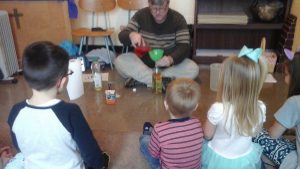
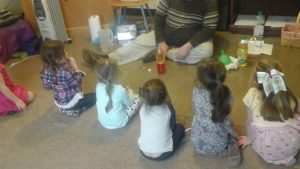
But why did the food coloring float?………SCIENCE!
The oil stays above the water because the oil is lighter than the water or, more specifically, less dense than water. The oil and water do not mix because of something called “intermolecular polarity.” Molecular polarity basically means that water molecules are attracted to other water molecules. They get along fine, and can loosely bond together (drops). This is similar to magnets that are attracted to each other. Oil molecules are attracted to other oil molecules, they get along fine as well. But the structures of the two molecules do not allow them to bond together. When Mr. John added the tablet of alka seltzer, it sank to the bottom and started dissolving and creating a gas. As the gas bubbles rose, they took some of the colored water with them. When the blob of water reached the top, the gas escaped and down went the water. Cool, huh? By the way, you can store your “Blobs In A Bottle” with the cap on, and then anytime you want to bring it back to life, just add another tablet.
Chemical Reaction
This week Ms. Ashlie filled in for Mr. John, and showed us a fun volcano science experiment!
Question of the week: What will happen when we add baking soda to white vinegar?
Materials needed:
- White vinegar
- Baking soda
- Measuring utensils
- Container
- Red sparkles/glitter
Our data: When Ms. Ashlie added the baking soda to the vinegar, it began to bubble over the side of the container just like a volcano!
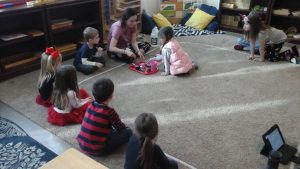
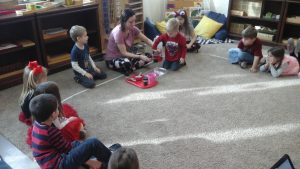
But why did the vinegar begin to bubble?…….SCIENCE!
Just like in a volcano, the lava starts to build and build until it begins to overflow! We call this a chemical reaction.
Thank you, Ms. Ashlie, for such a fun science experiment this week!
Dancing Raisins
“Carbonation”
Question of the week: What are the bubbles in the soda? What will happen when we put raisins in a fresh glass of ginger ale?
Materials needed:
- Ginger ale
- Raisins
- A glass
Our data: When Mr. John dropped several raisins into a glass of ginger ale, the raisins sunk to the bottom. The after a few moments the raisins were covered with bubbles and raised to the top, then fell to the bottom. This repeated for a several minutes.
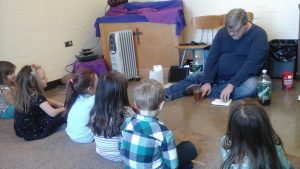
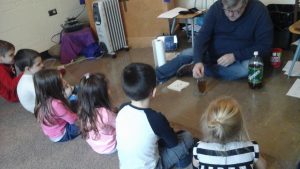
But why did the raisins bubble up to the top and then fall back down to the bottom?….SCIENCE!
The raisins are heavier than the ginger ale. Then the carbonated bubbles attach themselves to the raisins. When enough bubbles attach themselves to the raisins the raisins become “lighter” than the ginger ale. The carbonated bubbles lift the raisins to the top. When the bubbles reach the surface the bubbles break dropping the raisins to the bottom again.
“Gluep”
Polymers
Question of the week: What will happen if we mix Borax, Elmer’s glue, and water?
Materials needed:
- Borax
- Elmer’s glue
- Water
- A bag
- Container
- Food coloring
Our data: When Mr. John mixed the ingredients together, it became silly putty.
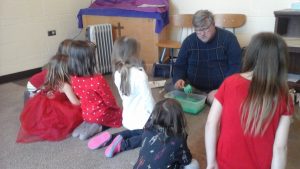
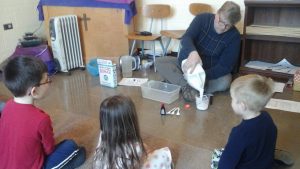
But why did the ingredients turn into silly putty?……..SCIENCE!
Borax is the compound that is responsible for hooking the glue’s molecules together to form the putty-like material. There are several different methods for making this putty-like material. Some recipes call for liquid starch instead of Borax soap. Either way, when you make this homemade silly putty you are learning about some of the properties of polymers.
We had so much fun in science this month! Thank you, Mr. John!
